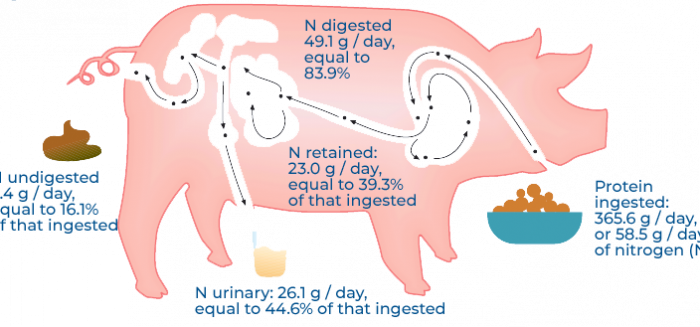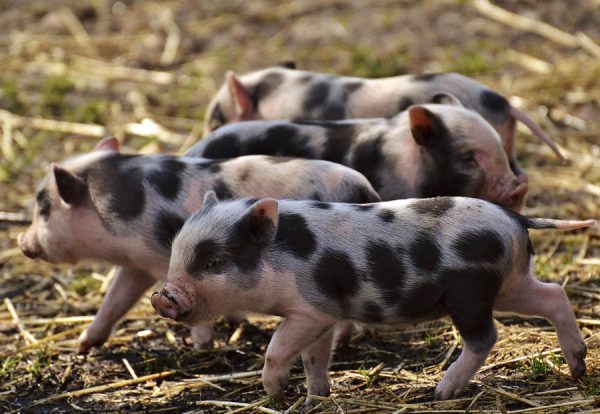Better utilisation of food proteins
The addition of Saviotan® Feed to the diet of growing pigs permits better utilisation of food proteins. Comparing the data in the two tables below a 4% improvement can be seen with the use of Saviotan® Feed. For this reason, hypoprotein diets can be adopted with commensurate savings. In the example a 12.3% crude protein diet was used against 14.2%.

Note: 18 castrated male pigs of an average weight of 153 kg were used in the test, divided into 3 groups of 6. For our purposes we consider only the control group, which received a 14% raw protein diet, and the treated group, which received a 12% raw protein diet, supplemented with 0.53% Saviotan® Feed. The presence of Saviotan® Feed did not alter the palatability of the feed.
Reduction in the amount of urinary nitrogen
The decidedly lower quantity of urinary nitrogen, or volatile nitrogenous substances, ensures better quality of the manure. This is in addition to the widely demonstrated anti-microbiotic properties of Saviotan® Feed.
Nitrogen balance > grams / day
| Item | Input | Output | Yield |
|---|---|---|---|
| eed | 67,2 | ||
| Faeces | 9,1 | ||
| Urine | 34,6 | ||
| Retained | 23,5 | ||
| Total | 67,2 | 43,7 | 23,5 |
Without tannin:
35% yield (23.5*100/67.2)
Nitrogen balance > grams / day
| Item | Input | Output | Yield |
|---|---|---|---|
| Feed | 58,5 | ||
| Faeces | 9,4 | ||
| Urine | 26,1 | ||
| Retained | 23,0 | ||
| Total | 58,5 | 35,5 | 23,0 |
With Saviotan® Feed tannin:
39% yield (23.0*100/58.5)
Energy balance > MJ / day
| Item | Input | Output | Yield |
|---|---|---|---|
| Feed | 54,01 | ||
| Faeces | 6,49 | ||
| Urine | 1,48 | ||
| Methane | 0,27 | ||
| Heat | 25,66 | ||
| Retained | 20,11 |
Without tannin:
37% yield (20.11*100/54.01)
Energy balance > MJ / day
| Item | Input | Output | Yield |
|---|---|---|---|
| Feed | 53,70 | ||
| Faeces | 6,27 | ||
| Urine | 1,29 | ||
| Methane | 0,27 | ||
| Heat | 25,84 | ||
| Retained | 20,03 |
With Saviotan® Feed tannin:
37% yield (20.03*100/53.70)
Addition of Saviotan® Feed in the feed
The addition of Saviotan® Feed in the growing pig feed in no way changes the metabolic utilisation of food energy (37% in both cases).
Enrichment of adipose tissue with acids supporting animal wellbeing
Analysis of the fatty acid composition of the adipose tissue of the tested pigs, samples taken at slaughter, and then analysed, showed no significant differences, except for the two cases of rumenic acid (C18: 1 trans 2) and conjugated linoleic acid (CLA), also called vaccenic acid (C18: 2 cis 9 trans 11), which are the two most important acids to health as regards the consumers.

CONTROL
0,15%
0,30%
Changes in the content of polyunsaturated fatty acids
This important observation only regards the pigs fed with the addition of 0.15% Saviotan® Feed and not those with 0.30%. This means that the product acts at low concentrations, so there is no need for excessive use. There were no differences found in all the other characteristics of the meat.
With 0.15% Saviotan® Feed the following results were obtained: + l 00% for rumenic, from 0.04 to 0.08 and + 18% vaccenic, from 0.09 to 0.11 gll0 per 100 g of lipids.
NOTE: The purpose of the test aimed was to see the effect of Saviotan® Feed not so much on nitrogen and energy balances, but on possible effects on production performance and on the characteristics of the meat and adipose tissue. The test took place in the Parma-San Daniele circuit. 42 castrated pigs were used in the test, of an average weight of 150 kg, divided into 3 groups of 14. All were fed a 14% raw protein diet, and 2 of the treated groups received 0.15% and 0.30% supplements of Saviotan® Feed in their feed. A decrease in the digestibility of food protein was found, of 78% in untreated pigs to 74% in treated pigs, but no differences were observed in growth and conversion indexes, confirming better utilisation of absorbed nitrogen.






